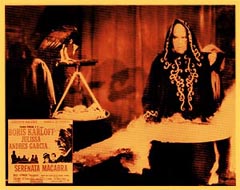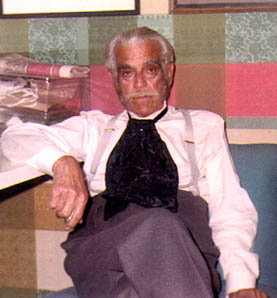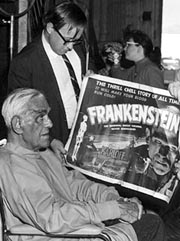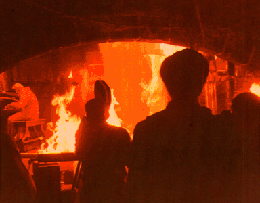|
I was very young then, and wanted so much to talk to Karloff about his career. Forry Ackerman was often also there, once
with his friend Teri Pinckard. She got into a discussion with Karloff about the Screen Actors Guild, which he had helped
found, and the Academy of Motion Picture Arts and Sciences, an organization he did not like and he made his opinion very
clear. An old friend of his, perhaps Edith Evans (at this remove in time, I no longer remember who he was referring to),
was associated with the Oscar ceremonies that hot spring in 1968. He was irked that she was linked to the "enemy"
and darkly muttered that she'd regret it. Karloff resented the Academy because he was around when it was founded; its initial
intent was as a tool of the studio bosses, a means of controlling the talent which had, in the late '20s, begun to become
a bit obstreperous. (This was a major reason the Screen Actors Guild was formed.)
THE FEAR CHAMBER

Someone, perhaps me, asked him if he would accept an honorary Oscar if one were offered. He replied that no, he would
never do anything of the sort, and that the Academy knew that. (Again, memory fades: he might even have said that he had
been offered such an award, and declined it.) This was the only time I saw Karloff become animated and enthusiastic discussing
labor relations and the status of actors in Hollywood. He spoke with great conviction and some excitement, punctuating his
remarks with contained hand gestures. I was impatient to talk about his horror movies, but I was much too shy to interrupt.
Now I wish I had written it all down as fast as I could, but I didn't want to be regarded as the next thing to a spy. (In
those days, portable tape recorders were not common.)
Being around Karloff remains a highlight of my life, but there were other benefits from visiting the sets. Yerye Beirute
was a costar in a couple of the films; he was a large, meaty guy, a busy character actor in Mexican films with quite a few
horror roles to his credit. He was relaxed around me and the people I brought by the set, friendly, wry and a little harassed.
Kubrick's 2001: A Space Odyssey had just been released, and Luis Enrique Vergara was as much of a Kubrick enthusiast
as I was; in fact, that was the reason he gave me carte blanche to visit the productions. I'd already seen the movie, but
Vergara hadn't, and quizzed me about it intensively. When he did see it, he sought me out on the set several times to talk
about the movie with great enthusiasm. I was very saddened to learn of his untimely death not long thereafter. It was his
death, in fact, that (somehow) prevented the films from being completed and released. I think Columbia Pictures backed out
of their partnership, and the Mexican footage was shot on a lower budget than was originally intended.

Karloff during a break in filming HOUSE OF EVIL, captured by Bill Warren's trusty Instamatic.
Jack Hill directed the American sequences of all four movies, although he rarely includes them on his resume. I barely spoke
to him, as he was harassed by the low budget and short schedules. But I was amused and very interested to notice that he
tied (with rope) an early portable video camera to the top of the 35mm Mitchell he was using as his principal camera. Jerry
Lewis had recently come up with this idea of shooting "instant dailies," and Hill spent a lot of time trying to
make the video playback work right. This was Vergara's idea, forced on Hill, who now feels he lost a lot of time while fooling
around with the video camera. But at least Vergara knew a visionary idea when he encountered one, since "video assist"
is now standard in Hollywood
The small soundstages still in use were sweatboxes. If I recall the dates correctly, it was only April shading into May,
but the weather was sweltering outside, and far worse inside the stages. As soon as a take was finished, the doors were flung
wide and huge fans mounted in them in an attempt to cool things down before the next take. I was intent on being very
serious about all this, and wore slacks, a white shirt, sports jacket and tie on every visit to the stage. I suffered,
and in the photos Walt Daugherty took on the set you can see the heat in my sweaty face and limp hair. I wasn't there the
day Karloff shot his last scenes for the Mexican quartet. He went back to England, returning to California briefly later
that year to film "The White Birch" segment of the TV series Name of the Game, his last film work of all.
Seeing Karloff work, act, while I was there, breathing the same overheated air, remains one of the highlights of my life.
I've met other actors and directors, become friends with some, but watching Boris Karloff act was a special experience.
It's one of those events for which there just aren't adequate words. I tried to express some of this directly to him. I'd
been hovering around his wheelchair, hoping to say the right thing, afraid that I was making him nervous, when I suddenly
blurted out, "Mr. Karloff, I really can't tell you how much I think of you. You've always been my favorite actor."
I stopped as abruptly as I'd begun, blushing, sure that what I had said was banal beyond belief.
|
 |
|
|
|
|
|
 |
|
|
 |
|
Karloff quickly reached out, took my hand in his wrinkled, brown one, and patted mine. He was clearly embarrassed himself,
but wanted to put me at my ease. "Why, thank you, young man," he said. "I have tried. It is good to know
someone cares." That's about as sentimental as possible, but it is what he said those years ago, in that small soundstage
on Santa Monica Boulevard.
But of course, he and Lugosi, Zucco and Atwill, Carradine and Chaney Jr., even Cushing and Price, are all being borne into
the misty distance by the river of time. Karloff and the others remain significant names to the movie fans of my generation
and to those of the next few after mine. But they're all being borne away into the distance, fading from the fickle consensus
consciousness. A lot of younger people today who consider themselves knowledgeable movie buffs could possibly name three
or four Karloff movies, but rarely any more than that. He is definitely a figure of the past.
This, to me, is sad, wistful, melancholy, but it's the way of the world. I regret it, but I can't hold back the flow; no
one can. It's evolution, natural change. Fame fades. There will always be those who discover Karloff and the others through
video or television, often introduced to them by older relatives and friends but it's a dwindling number, shrinking more
and more as the old movies become increasingly quaint, artifacts of little more than archaeological interest.
Remembering his old friend the Monster 37 years after appearing in FRANKENSTEIN

Even the biggest stars fade away in just the same manner; there are far fewer John Wayne fans now than there were even ten
years ago. Lana Turner, Clark Gable, Bette Davis the names are fading away like the legend at the beginning of Star Wars,
rising into the darkness, becoming invisible. There was a good reason Forry Ackerman started the "Lon Chaney Shall Not Die!"
feature in Famous Monsters of Filmland he knew that without this frequent reinforcement, Chaney ran the risk of disappearing
in this manner. (Michael Blake's fine books have helped keep Chaney's memory alive, too.)
Actually, as it turned out, Chaney's brilliance as an actor and make-up artist made him into one of those very rare stars
whose fame fades far more slowly. Marilyn Monroe's fame hangs on because of her tragic, even mysterious, death. Humphrey
Bogart is still known more widely than most other stars of his generation because of his late-in-life love story, and because
his beautiful homely face so fully matched his usual persona. And of course, there's Casablanca.
But Karloff was a polite, mostly unremarkable English gentleman who became famous relatively late in life, worked hard for
many years, and died quietly at an advanced age. He's recalled whenever one of his films is remade, and/or issued on video,
but mostly he's gently fading into the background. Even those of my generation had already largely lost a sense of his unfolding
career; each new movie was clearly one nearer the approaching end. We can now watch Targets back to back with The
Black Room, or House of Rothschild with The Strange Door. We cannot perceive his two periods of Broadway
fame the way people living at the time could as wonderful aberrations/capstones to his career as the world's most famous
horror movie star.
Even when we look at his filmography, we can't glance sideways, so to speak, and see what was going on at the same time with
other movies, other actors. This is one reason why it's often a jolting surprise to find movie sections of older newspapers,
discovering what films were playing at the same time.
Karloff's career is over and done with; it's history, no longer something living and evolving. Those of us who love these
movies won't let his memory die -- but eventually we ourselves will. I was there as he filmed his last movies; I wouldn't
trade the experience for any amount of money. But even my visits are just part of Karloff's history; it's not fading to black,
it's a long, long lap dissolve, but it's disappearing nonetheless, just as we're all borne away on that river of time.

Going out in style. Karloff at the organ during the fiery finale of House of Evil.

Bill Warren is the author of SET VISITS featuring 32 interviews from the sets of sci-fi and horror movies, and KEEP
WATCHING THE SKIES, an exhaustive look at science fiction movies of the fifties, as well as THE EVIL DEAD COMPANION,
a behind the scenes look at the popular film series. Bill's books can be ordered from Amazon.com.
Keep Watching the Skies!
The Evil Dead Companion
Set Visits
|
 |
|
|
 |
|